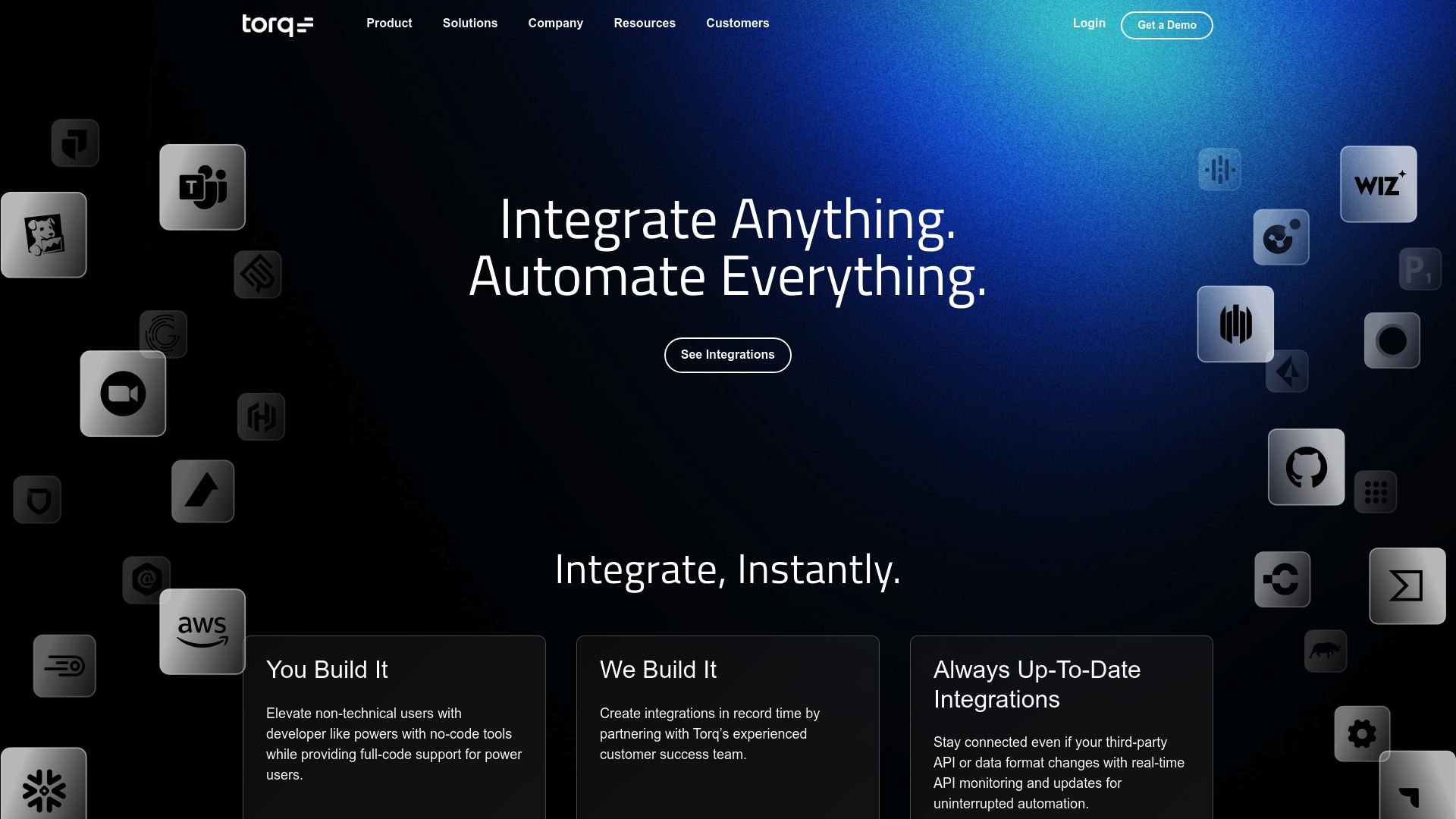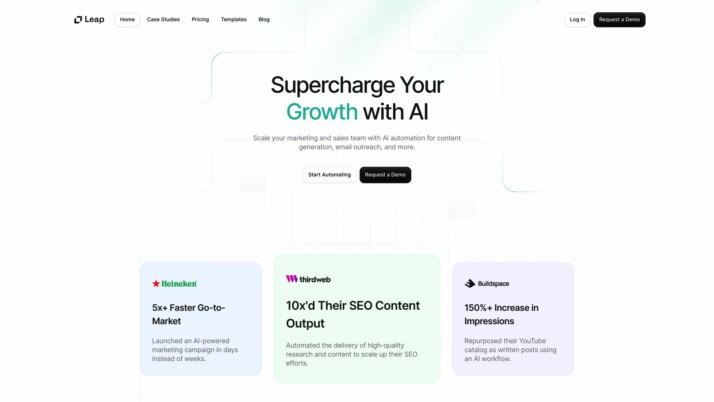Torq Hyperautomation vs. Leap AI: Comparing Security and AI Capabilities
AI technology revolutionizes business operations, but choosing the right platform can be daunting. This comparison of Torq Hyperautomation vs. Leap AI, and SmythOS illuminates key differences in security automation, AI development, and comprehensive agent capabilities. We explore how each platform addresses workflow automation, AI model integration, and enterprise-grade features. Whether you’re a developer seeking advanced API integrations, a business leader focused on scalability and compliance, or a non-technical user looking for accessible AI tools, this review provides insights to guide your decision. Discover which platform best aligns with your organization’s needs for AI-driven innovation and efficiency.
Torq Hyperautomation Overview
Torq Hyperautomation delivers an enterprise-grade security hyperautomation platform designed to revolutionize cybersecurity operations. The platform empowers organizations to automate complex security processes, remediate incidents at scale, and orchestrate responses across their entire security infrastructure stack.


Torq’s platform stands out with its visual workflow designer, enabling security teams to create sophisticated automation workflows without coding. This no-code approach democratizes security automation, allowing professionals to focus on strategic tasks rather than repetitive processes. The system supports a wide array of triggers, from third-party service events to scheduled tasks, ensuring comprehensive coverage of security scenarios.
Torq’s platform stands out with its visual workflow designer, enabling security teams to create sophisticated automation workflows without coding.
Key features include customizable workflows, extensive third-party integrations, and automated case management. These components work in concert to streamline security operations, from incident detection to resolution. Torq’s workspace feature facilitates collaboration and resource sharing, with role-based access control enhancing security and efficiency.
While Torq excels in security automation, it lacks specific AI agent capabilities and multimodal interactions. The platform focuses on orchestrating existing security tools rather than deploying autonomous AI agents. This specialization makes Torq ideal for organizations prioritizing security workflow automation but may limit its applicability in broader AI agent scenarios.
Torq Hyperautomation integrates seamlessly with existing security infrastructures, supporting API-based interactions and various authentication methods. This flexibility allows organizations to leverage their current investments while enhancing their security posture through automation. The platform’s scalability and enterprise-grade design make it suitable for organizations of all sizes, from growing businesses to large enterprises with complex security needs.
Leap AI Overview
Leap AI empowers users to create sophisticated AI workflows without coding expertise. The platform’s no-code visual interface allows quick development of AI-powered applications for tasks ranging from content generation to data analysis. Leap AI integrates with popular AI models like OpenAI GPT and Stable Diffusion XL, offering versatility across text, image, and even music generation.
The platform shines in its accessibility, providing a rich template library that accelerates development for common use cases such as blog post creation and lead summarization. Leap AI’s strength lies in its ability to democratize AI technology, making it available to both technical and non-technical users alike. The drag-and-drop interface simplifies complex AI processes, enabling rapid prototyping and deployment of AI solutions.


Leap AI empowers users to create sophisticated AI workflows without coding expertise. The platform’s no-code visual interface allows quick development of AI-powered applications for tasks ranging from content generation to data analysis.
Leap AI’s comprehensive SDK support, including RESTful API, TypeScript, and Python, facilitates seamless integration into existing applications. This flexibility allows developers to incorporate Leap AI’s capabilities into their projects effortlessly. The platform also boasts extensive integration options with popular tools like Slack, Hubspot, and Zapier, enhancing its utility across various business processes.
Leap AI offers model training capabilities, allowing users to fine-tune AI models with their own datasets. This feature enhances the specificity and accuracy of AI outputs, tailoring them to unique business needs. However, the platform’s focus on ease of use may limit advanced customization options for highly specialized AI applications.
While Leap AI excels in simplifying AI development, it may not offer the depth of features required for complex, enterprise-grade AI systems. The platform’s strength in rapid deployment and user-friendly design makes it ideal for small to medium-sized businesses and individual developers looking to leverage AI technology quickly. For organizations requiring more advanced AI capabilities or extensive customization, alternative solutions might be necessary.
Feature Comparison
Torq Hyperautomation and Leap AI offer distinct approaches to automation and AI development. Torq excels in security-focused workflow automation, providing a robust platform for orchestrating complex security processes. Its visual workflow designer enables security teams to create sophisticated automation without coding. However, Torq lacks specific AI agent capabilities and multimodal interactions, focusing instead on orchestrating existing security tools.
Leap AI, in contrast, empowers users to create AI workflows across various domains without coding expertise. Its drag-and-drop interface and integration with popular AI models like OpenAI GPT and Stable Diffusion XL offer versatility in text, image, and even music generation. Leap AI’s strength lies in democratizing AI technology for both technical and non-technical users. However, it may not provide the depth of features required for complex, enterprise-grade AI systems or extensive customization for highly specialized applications.
The platforms diverge significantly in their core components and security features. Torq Hyperautomation emphasizes enterprise-grade security, with features like detailed execution logs, role-based access control, and support for various authentication methods. Leap AI focuses more on accessibility and rapid AI application development, offering a rich template library and model training capabilities. This difference highlights the trade-offs between specialized security automation and general-purpose AI development tools.
Feature Comparison Table
| Torq Hyperautomation | Leap AI | SmythOS | |
|---|---|---|---|
| CORE FEATURES | |||
| Hosted Agents (Dev, Production) | ✅ | ❌ | ✅ |
| Autonomous Agents | ✅ | ❌ | ✅ |
| Explainability & Transparency | ❌ | ❌ | ✅ |
| Debug Tools | ✅ | ❌ | ✅ |
| Problem-Solving Capabilities | ❌ | ✅ | ✅ |
| Multi-Agent Collaboration | ✅ | ❌ | ✅ |
| Human-AI Interaction | ❌ | ✅ | ✅ |
| SECURITY | |||
| Constrained Alignment | ✅ | ❌ | ✅ |
| COMPONENTS | |||
| Huggingface AIs | ❌ | ✅ | ✅ |
| Zapier APIs | ❌ | ✅ | ✅ |
| All other APIs, RPA | ❌ | ✅ | ✅ |
| Logic | ❌ | ✅ | ✅ |
| Data Lakes | ✅ | ❌ | ✅ |
| DEPLOYMENT OPTIONS (EMBODIMENTS) | |||
| Deploy as API | ❌ | ✅ | ✅ |
| Production Domains | ❌ | ✅ | ✅ |
| API Authentication (OAuth + Key) | ❌ | ✅ | ✅ |
| Deploy as Scheduled Agent | ❌ | ✅ | ✅ |
| Scalability | ❌ | ✅ | ✅ |
| DATA LAKE SUPPORT | |||
| Hosted Vector Database | ✅ | ❌ | ✅ |
| Sitemap Crawler | ❌ | ✅ | ✅ |
| YouTube Transcript Crawler | ❌ | ✅ | ✅ |
| URL Crawler | ❌ | ✅ | ✅ |
| PDF Support | ❌ | ✅ | ✅ |
Best Alternative to Torq Hyperautomation and Leap AI
SmythOS stands out as the superior alternative to Torq Hyperautomation and Leap AI, offering a comprehensive platform for AI agent development and deployment. We combine the strengths of both competitors while addressing their limitations, providing a versatile solution for businesses of all sizes.
Our platform excels in ease of use, featuring an intuitive drag-and-drop interface that simplifies AI workflow creation. Unlike Torq’s security-focused approach or Leap’s general AI development tools, SmythOS delivers a balanced solution suitable for both specialized security tasks and broader AI applications. We empower users to build sophisticated AI agents without extensive coding knowledge, democratizing AI technology across industries.
SmythOS boasts an unmatched feature set, surpassing both Torq and Leap in critical areas. We offer autonomous agents capable of complex problem-solving, multi-agent collaboration, and seamless human-AI interaction. Our platform supports a wide range of deployment options, including APIs, webhooks, scheduled agents, and chatbots, providing flexibility that neither Torq nor Leap can match. Additionally, SmythOS integrates with various AI models and data sources, enabling users to leverage cutting-edge technologies in their projects.
SmythOS boasts an unmatched feature set, surpassing both Torq and Leap in critical areas. We offer autonomous agents capable of complex problem-solving, multi-agent collaboration, and seamless human-AI interaction.
The unlimited use cases supported by SmythOS set us apart from our competitors. While Torq focuses primarily on security automation and Leap targets general AI development, our platform adapts to diverse scenarios across industries. From automating business processes to creating advanced virtual assistants, SmythOS provides the tools and scalability needed to tackle any AI challenge. Our robust integration capabilities and support for multiple data formats ensure that users can seamlessly incorporate AI agents into their existing workflows and systems.
By choosing SmythOS, users gain access to a powerful, versatile, and user-friendly platform that combines the best of both worlds. We offer the security-focused features of Torq and the AI development capabilities of Leap, while providing additional functionalities and ease of use that neither competitor can match. With SmythOS, businesses can confidently build, deploy, and scale AI solutions that drive innovation and efficiency across their operations.
Conclusion
Torq Hyperautomation and Leap AI offer powerful solutions for security automation and AI development respectively, but SmythOS emerges as the superior choice for businesses seeking comprehensive AI agent capabilities. Torq excels in security-focused workflow automation, while Leap AI democratizes AI development with its user-friendly interface. However, SmythOS combines the best of both worlds and goes beyond.
SmythOS stands out with its versatile ’Create Once, Deploy Anywhere’ approach, allowing users to build AI agents that seamlessly integrate across multiple platforms. The platform’s drag-and-drop interface, extensive integration ecosystem, and support for various AI models make it accessible to both technical and non-technical users. Unlike Torq and Leap AI, SmythOS offers advanced features like multi-agent orchestration, enabling teams of AI agents to collaborate on complex tasks.
For businesses looking to harness the full potential of AI, SmythOS provides unparalleled flexibility and scalability. Its comprehensive suite of tools, from visual builders to debugging capabilities, ensures that organizations can create, deploy, and manage sophisticated AI solutions with ease. Whether you’re automating security processes, developing AI-powered applications, or seeking to innovate across various domains, SmythOS offers the robust framework needed to drive significant advancements.
To experience the future of AI agent development and deployment, explore SmythOS’s diverse range of AI-powered agent templates. These templates cover multiple business categories and offer a starting point for streamlining your operations. Ready to take the next step? Create a free SmythOS account and start building your AI workforce today, with no time limit and a 30-day money-back guarantee. Unlock the power of AI for your business and join the economic revolution that SmythOS is spearheading.
Last updated:
Disclaimer: The information presented in this article is for general informational purposes only and is provided as is. While we strive to keep the content up-to-date and accurate, we make no representations or warranties of any kind, express or implied, about the completeness, accuracy, reliability, suitability, or availability of the information contained in this article.
Any reliance you place on such information is strictly at your own risk. We reserve the right to make additions, deletions, or modifications to the contents of this article at any time without prior notice.
In no event will we be liable for any loss or damage including without limitation, indirect or consequential loss or damage, or any loss or damage whatsoever arising from loss of data, profits, or any other loss not specified herein arising out of, or in connection with, the use of this article.
Despite our best efforts, this article may contain oversights, errors, or omissions. If you notice any inaccuracies or have concerns about the content, please report them through our content feedback form. Your input helps us maintain the quality and reliability of our information.
